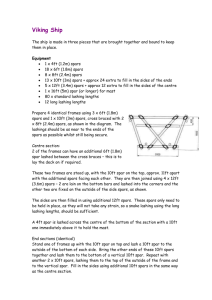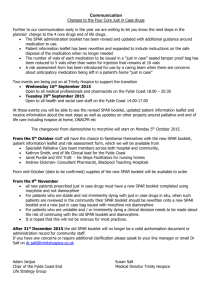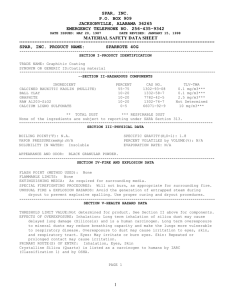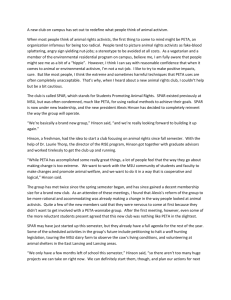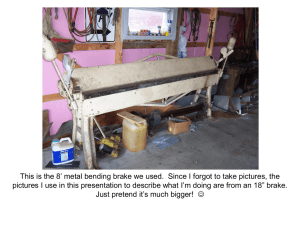View - International Journal of Aerospace and Mechanical
advertisement
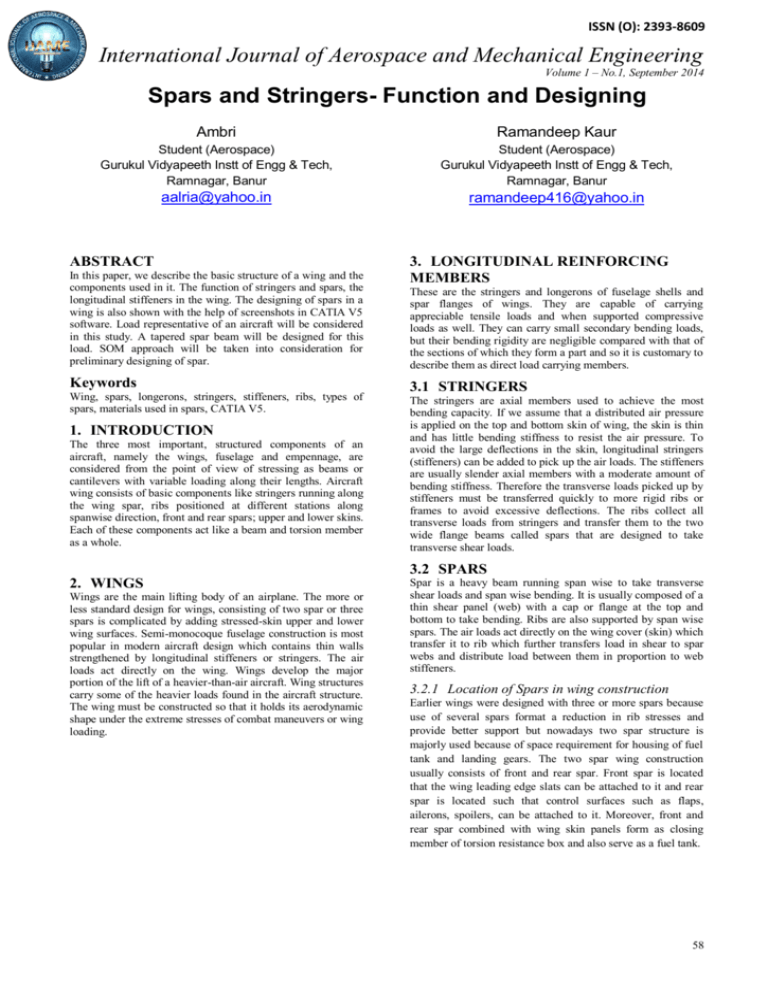
ISSN (O): 2393-8609 International Journal of Aerospace and Mechanical Engineering Volume 1 – No.1, September 2014 Spars and Stringers- Function and Designing Ambri Ramandeep Kaur Student (Aerospace) Gurukul Vidyapeeth Instt of Engg & Tech, Ramnagar, Banur Student (Aerospace) Gurukul Vidyapeeth Instt of Engg & Tech, Ramnagar, Banur aalria@yahoo.in ramandeep416@yahoo.in ABSTRACT In this paper, we describe the basic structure of a wing and the components used in it. The function of stringers and spars, the longitudinal stiffeners in the wing. The designing of spars in a wing is also shown with the help of screenshots in CATIA V5 software. Load representative of an aircraft will be considered in this study. A tapered spar beam will be designed for this load. SOM approach will be taken into consideration for preliminary designing of spar. Keywords Wing, spars, longerons, stringers, stiffeners, ribs, types of spars, materials used in spars, CATIA V5. 1. INTRODUCTION The three most important, structured components of an aircraft, namely the wings, fuselage and empennage, are considered from the point of view of stressing as beams or cantilevers with variable loading along their lengths. Aircraft wing consists of basic components like stringers running along the wing spar, ribs positioned at different stations along spanwise direction, front and rear spars; upper and lower skins. Each of these components act like a beam and torsion member as a whole. 3. LONGITUDINAL REINFORCING MEMBERS These are the stringers and longerons of fuselage shells and spar flanges of wings. They are capable of carrying appreciable tensile loads and when supported compressive loads as well. They can carry small secondary bending loads, but their bending rigidity are negligible compared with that of the sections of which they form a part and so it is customary to describe them as direct load carrying members. 3.1 STRINGERS The stringers are axial members used to achieve the most bending capacity. If we assume that a distributed air pressure is applied on the top and bottom skin of wing, the skin is thin and has little bending stiffness to resist the air pressure. To avoid the large deflections in the skin, longitudinal stringers (stiffeners) can be added to pick up the air loads. The stiffeners are usually slender axial members with a moderate amount of bending stiffness. Therefore the transverse loads picked up by stiffeners must be transferred quickly to more rigid ribs or frames to avoid excessive deflections. The ribs collect all transverse loads from stringers and transfer them to the two wide flange beams called spars that are designed to take transverse shear loads. 3.2 SPARS 2. WINGS Wings are the main lifting body of an airplane. The more or less standard design for wings, consisting of two spar or three spars is complicated by adding stressed-skin upper and lower wing surfaces. Semi-monocoque fuselage construction is most popular in modern aircraft design which contains thin walls strengthened by longitudinal stiffeners or stringers. The air loads act directly on the wing. Wings develop the major portion of the lift of a heavier-than-air aircraft. Wing structures carry some of the heavier loads found in the aircraft structure. The wing must be constructed so that it holds its aerodynamic shape under the extreme stresses of combat maneuvers or wing loading. Spar is a heavy beam running span wise to take transverse shear loads and span wise bending. It is usually composed of a thin shear panel (web) with a cap or flange at the top and bottom to take bending. Ribs are also supported by span wise spars. The air loads act directly on the wing cover (skin) which transfer it to rib which further transfers load in shear to spar webs and distribute load between them in proportion to web stiffeners. 3.2.1 Location of Spars in wing construction Earlier wings were designed with three or more spars because use of several spars format a reduction in rib stresses and provide better support but nowadays two spar structure is majorly used because of space requirement for housing of fuel tank and landing gears. The two spar wing construction usually consists of front and rear spar. Front spar is located that the wing leading edge slats can be attached to it and rear spar is located such that control surfaces such as flaps, ailerons, spoilers, can be attached to it. Moreover, front and rear spar combined with wing skin panels form as closing member of torsion resistance box and also serve as a fuel tank. 58 ISSN (O): 2393-8609 International Journal of Aerospace and Mechanical Engineering Volume 1 – No.1, September 2014 3.2.2 Cross-sections of spars and stringers Cross-sections of Spars are only of two types I section and C section. One may note that it is necessary to include many form of stringers so as to pick the best types for the particular structure-typical shapes being Z-section, Y-section, hatsection, J-section or integrally stiffened panels and so on. The highest possible allowable stress for a given load and material will result in lowest weight. If stringers are to be used, shape should be carefully studied. E.g. hat section will have a higher crippling stress than normal hat shape. 3.2.3 Skin stringer connection The stringers and spars are attached to the skins by lines of rivets, spot welds or perhaps bonding. These joints will be called upon o transmit forces mainly along their length. Forces parallel to skin and directed at right angles to stringers will be limited by torsional flexibility of these members. Forces normal to the skin will be limited in magnitude by small bending strength of skin and stringer. 3.2.4 Uses of different cross-sections of stringers Figure below shows some typical stringer cross-sections used on existing aircraft structures. Fig. (a) and (b) are most popular in recent structural designs especially the (a) configuration due to its high structural efficiency and easy assembly. Fig. (b) is not as efficient as (a) but has good fail-safe characteristics due to double row of fasteners attached between stringers and skin. This J-section stringer is used to splice the span wise wing skins or fuselage longitudinal skin joints. Fig. (c) and (d) which are used on some transport aircrafts are not adopted again in structural design because of its complication of the stringer attached to rib structure. Y-stringer configuration is not accepted by commercial operators owing to corrosion problem even though this configuration has the highest structural efficiency. Fig. (e) hat-section stringer configuration is not accepted by structural design because it has the same corrosion problem but it could be used on wing upper surfaces as fuel tank vent passage as well as compression member. 59 ISSN (O): 2393-8609 International Journal of Aerospace and Mechanical Engineering Volume 1 – No.1, September 2014 4. TYPES OF SPARS There are two types of spars: 1. 2. Shear web spar (widely adapted to design modern wing) Truss type The two primary conditions which determine efficiency of a spar are its construction cost and its efficiency as its load carrying member. Semi-tensioned type spars (shear) are much better than the truss type spars because of construction cost and efficiency. 4.1 Spars in different kinds of aircrafts In case of transport wing box, spar caps fabricated from machined forging are used. Front spar forged cap extends from airplane centerline and outboard of fuselage while rear spar forged cap extends from airplane centerline to aerodynamic break. Spar webs are continuous in high load transfer region. Most of lightly loaded wings for general aircraft adapt a single main front spar and an auxiliary rear spar construction. In case of high swept fighter wing, rear spar should be the main spar and front spar be auxiliary spar. 4.2 Materials used to manufacture spars and stringers Most common used materials are alluminium alloys because of their stiffness and high structural efficiency. The alluminium alloys under following conditions are used 1. 2. 3. 4. 2014-T6 2024-T4 (extrusion) 2024-T81 7075-T6 60 ISSN (O): 2393-8609 International Journal of Aerospace and Mechanical Engineering Volume 1 – No.1, September 2014 5. 6. 7075-T6 (extrusion) Others 5. DESIGNING IN CATIA V5 5.1 Software description CATIA V5 is a multi-platform CAD/CAM/CAE commercial software suite developed by Dassault Systemes. It is a designing software. All sorts of mechanical parts, automobile models, aircraft components and models can be designed with its help. 5.2 Designing of front spar, rear spar and 20 stringers on airfoil shape Fig 4: A stringer on an airfoil Fig 1: Front spar in CATIA Fig 5: 20 stringers on the airfoil boundary Fig 2: Front and rear spar Fig 6: Wing structure consisting spars and stringers 6. ACKNOWLEDGMENTS Our thanks to the experts who have contributed towards development of the research paper. 7. REFERENCES [1] Aircraft Basic Construction Fig 3: Stringer and spar connected with skin [2] Design and Analysis of A Spar Beam For The Vertical Tail of A Transport Aircraft by Vinod S. Muchchandi, S. C. Pilli [3] Introduction to flight; Anderson, J.D. 61
